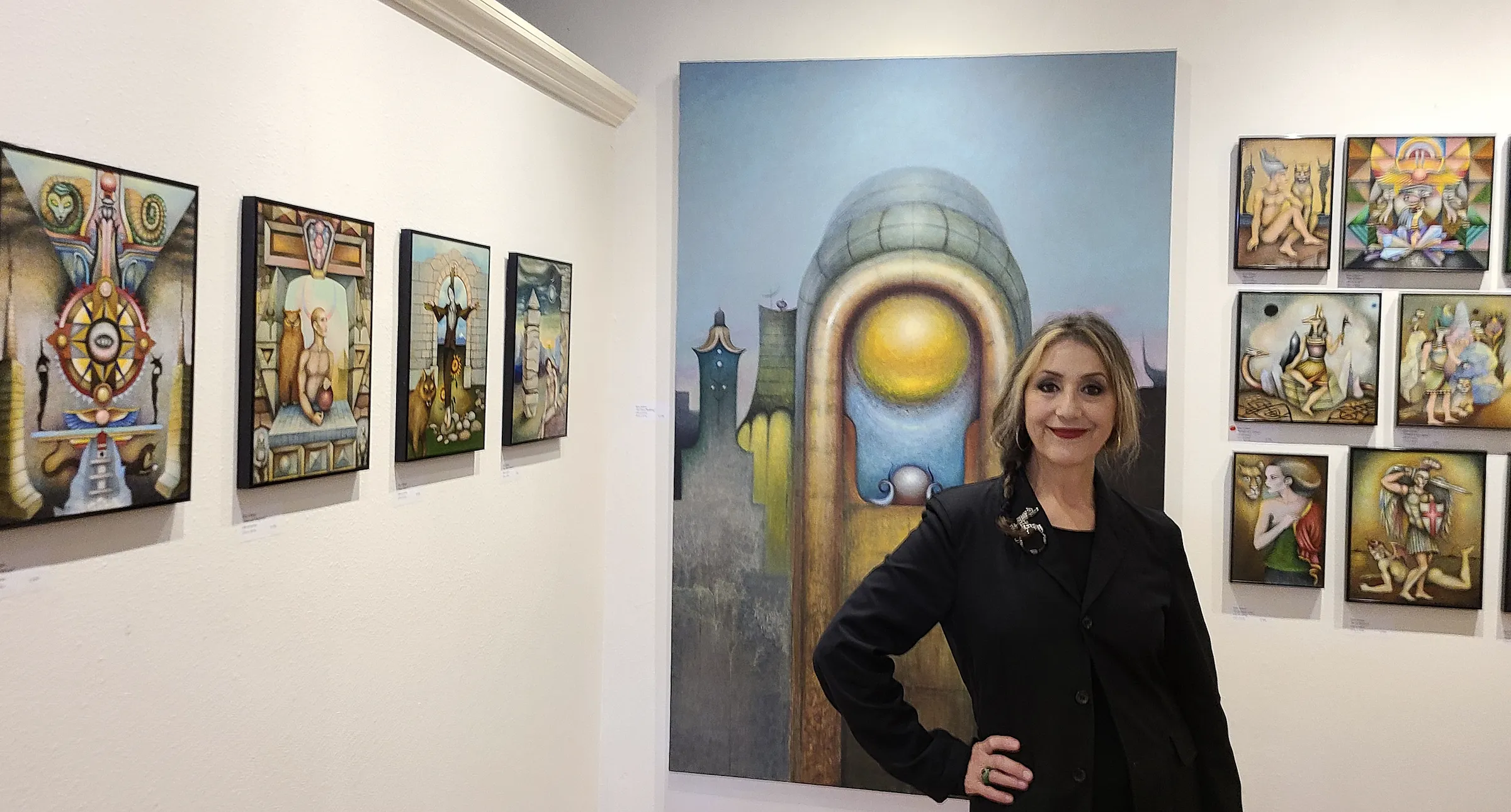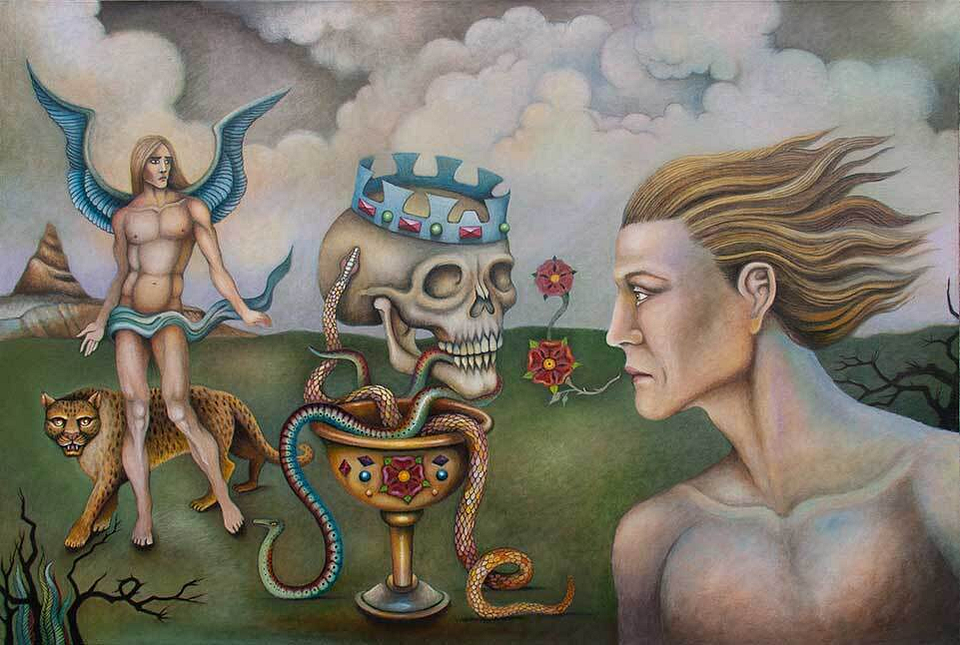
The Art of Kim Seltzer: Love Conquers All
Art Collective Gallery
Rogers, Arkansas
Through Nov. 30
Startling portrayals of mythological and historical figures inhabit the otherworldly paintings of Kim Seltzer in Love Conquers All, a one-woman show at the Art Collective Gallery in Rogers.
Religious Iconography blends with horror themes in Seltzer’s series of disciplined, lustrous paintings. “This collection is about the ripple of history and its mythic aspect brought to the present,” she says.
Seltzer’s paintings interpret ancient figures and symbols of myth and magic from several cultures and religions: Pharaohs and pagans, bejeweled and bedecked with fabric raiment. Snakes and chalices, falcon-formed Horus, and a Christlike tinker. Abraham and Isaac. Dejected angels and forlorn saints. Anubis, god of the dead. Deities of India in anatomical detail alongside naked, buff knights of the Crusades and human-size cats like the rain goddess Tefnut.
Seltzer’s influences include the emotion-laden Symbolism movement and the pre-beatnik graphics of German Expressionism. She studied artists Gustave Moreau and Aleister Crowley, and author Joséphin Péladan. Around the end of the 19th century, a group of such artists, occultists and Edwardians fixated on Egypt and the east.
Seltzer says she typically finishes six small paintings and two large ones per year. She works mostly on board but occasionally on textiles like the show’s title piece “Omnia Vincit Amor.” She builds up the paint in many layers, yet the surfaces are smooth, glowing, and sometimes finished with a clear coat.
Love Conquers All lends corporeal figures to murky heroes and places of myth and religion. I visited the exhibit twice, and it’s mind altering.
Imagine you awaken in an archaic landscape with weird animals and buildings. On your body is some splendid new jewelry. You drink a goblet of wine. You’re enjoying yourself –- but not sure how you got there. Maybe it’s time to charm a viper, visit those famous neighbors in a pyramid, or dance with a sexy godhead from India.
You’re feeling at home in Kim Seltzer’s eccentric otherworld, somewhere between heaven and hell.
Raised in a military family, Seltzer was born in Frankfurt, Germany and moved to Missouri –- and then Italy, where she started painting, immediately embracing it as a lifelong calling.
Seltzer studied illustration at the San Francisco Academy of Art University. She was a student of Howard Brodie, a war artist who sketched the gritty military life of World War II and Vietnam. As a courtroom artist, Brodie drew the famous image of defendant Bobby Seale gagged and strapped to his chair at the Chicago Seven Trial.
Seltzer slipped into the San Francisco art underground, designing punk magazines and band posters. She attempted to bring expressionism and color to the chaotic typography and mangled photographs of the copier-art genre.
Moving to New York City, she was art director of EXIT, a tabloid magazine about comic art, science fiction and graphics published from 1984 through 1992 by George Petros and the late Adam Parfrey. The two esoteric authors and book-makers sometimes explored transgressive aspects of culture.
Seltzer and partners had wild fun publishing the in-crowd magazine at the advent of the East Village Art movement. They partied all over the city including CBGB. The partners once brought her to Jack Sarfatti, a theoretical physicist and academic outlaw, who needed an illustrator for his latest book. That gig didn’t materialize, but she designed advertising for the Liz Claiborne fashion label.
Seltzer was selected for three years in a row, through 2021, at the annual group show Everything But The Kitchen Sink at the La Luz de Jesus Gallery in Los Angeles. She was also featured by the San Francisco Chronicle at one of the Armory shows of the 1980s.
A veteran illustrator and designer, Seltzer has earned a steady living in publishing. She appreciates the work of creating beautiful graphics, but sometimes resents that the job takes time and energy away from painting. She worries that working in commercial art diminishes one’s reputation as a painter. In her case, that’s unlikely because her talent is expansive.

Seltzer was living in Portland, Oregon and sold some paintings, but says she didn’t fit in with a young, anarchistic art community. Her ex-publisher George Petros spoke of the growing art scene around Bentonville.
She applied for that brief-but-world-famous recruitment scheme called Life Works Here, which offered remote workers and creatives $10,000 and a bicycle to move to Northwest Arkansas. Seltzer was accepted, so she relocated from Portland 18 months ago. She’s building an art studio in a house that she bought in semi-rural Bella Vista.
“I’m more Brooklyn than Bentonville,” admits Seltzer, whose father is from Bensonhurst. She can still display some downtown badassitude. A woman at a recent church event noticed Seltzer’s clothing and jewelry and politely asked if she’s a satanist. (No, ma’am.)






